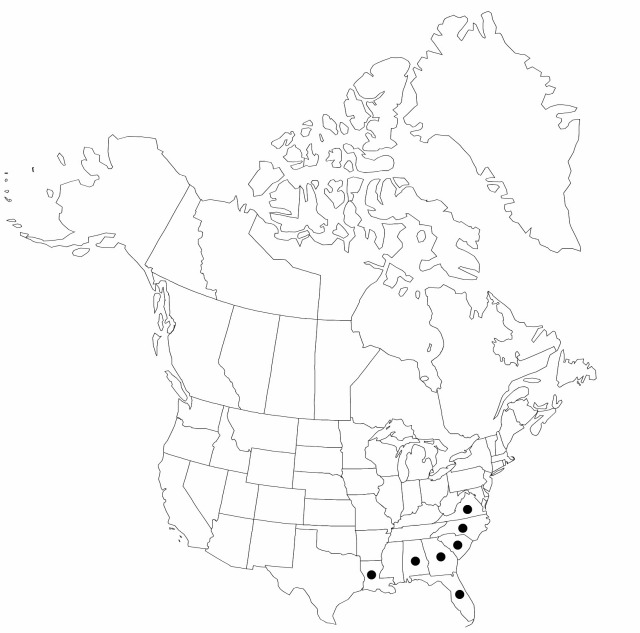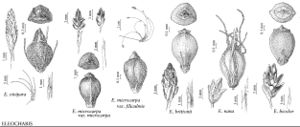Difference between revisions of "Eleocharis vivipara"
Hort. Berol. 1: 283. 1827.
FNA>Volume Importer |
FNA>Volume Importer |
||
| Line 12: | Line 12: | ||
|name=Chlorocharis vivipara | |name=Chlorocharis vivipara | ||
|authority=(Link) Rikli | |authority=(Link) Rikli | ||
| − | }}{{Treatment/ID/Synonym | + | }} {{Treatment/ID/Synonym |
|name=Eleocharis curtisii | |name=Eleocharis curtisii | ||
|authority=Small | |authority=Small | ||
| Line 30: | Line 30: | ||
|elevation=0–80 m | |elevation=0–80 m | ||
|distribution=Ala.;Fla.;Ga.;La.;N.C.;S.C.;Va. | |distribution=Ala.;Fla.;Ga.;La.;N.C.;S.C.;Va. | ||
| − | |discussion=<p>Most specimens of Eleocharis vivipara are from Florida. Identification of vegetative (often aquatic) specimens is sometimes tentative. Eleocharis vivipara is often confused with E. microcarpa and E. brittonii, and sometimes with E. baldwinii. The red-spotted band at the sheath apex and the gray, cancellate achenes are characteristic of E. vivipara.</p> | + | |discussion=<p>Most specimens of <i>Eleocharis vivipara</i> are from Florida. Identification of vegetative (often aquatic) specimens is sometimes tentative. <i>Eleocharis vivipara</i> is often confused with <i>E. microcarpa</i> and <i>E. brittonii</i>, and sometimes with <i>E. baldwinii</i>. The red-spotted band at the sheath apex and the gray, cancellate achenes are characteristic of <i>E. vivipara</i>.</p> |
|tables= | |tables= | ||
|references= | |references= | ||
| Line 54: | Line 54: | ||
|publication year=1827 | |publication year=1827 | ||
|special status= | |special status= | ||
| − | |source xml=https://jpend@bitbucket.org/aafc-mbb/fna-data-curation.git/src/ | + | |source xml=https://jpend@bitbucket.org/aafc-mbb/fna-data-curation.git/src/8f726806613d60c220dc4493de13607dd3150896/coarse_grained_fna_xml/V23/V23_133.xml |
|genus=Eleocharis | |genus=Eleocharis | ||
|subgenus=Eleocharis subg. Eleocharis | |subgenus=Eleocharis subg. Eleocharis | ||
Revision as of 16:05, 18 September 2019
Plants perennial, short-rhizomatous, forming dense clumps, often entirely vegetative; rhizomes caudexlike, ascending, internodes and scales hidden by crowded culms and sheaths, 0.5 mm thick. Culms often arching, often sering as stolons, broadly elliptic, (4–)7–38(–45) cm × (0.1–)0.3–0.7 mm, soft to firm. Leaves: distal leaf sheaths persistent or disintegrating, yellowish to pale brown, sometimes mottled or wholly red-brown, membranaous to papery, apex acute to narrowly obtuse. Spikelets: basal spikelets absent; usually proliferous, ovoid to ellipsoid to linear or terete, 3.3–9.6 × 1.2–2.3 mm, apex acute; proximal scale empty, persistent, amplexicaulous, similar to floral scales (usually slightly longer, midrib broadly green); subproximal scale with a flower; floral scales spiraled, 5–25, 4–8 per mm of rachilla, pale brown, usually spotted, streaked or mottled red-brown to purple, midribs green or green and red-brown, elliptic to obovate, 1.8–2.7 × 1–1.5 mm, membranous to chartaceous (papery), midrib evident to prominent, apex rounded to obtuse. Flowers: perianth bristles 5–6, red-brown (proximally often white), shorter than to equaling tubercle, rarely longer, 0.9–1.3(–2) mm; spinules sparse, retrorse, sharply acute; stamens 3; anthers yellow, 0.8–1.8 mm; styles 3-fid. Achenes gray or greenish, obovoid or obpyriform, trigonous, angles very prominent, 0.6–0.9 × 0.55–0.8 mm, apex constricted proximal to tubercle, finely honeycomb-reticulate at 10–20X, each face with 20 or more rows of evident enlarged cells. Tubercles whitish, gray, brown, or greenish black, pyramidal, trigonous, 0.2–0.5 × 0.4–0.5 mm.
Phenology: Fruiting spring–fall.
Habitat: Sandy and peaty soils, ditches, pond margins, shallow waters bordering pine-flatwoods and pine-palmetto scrub
Elevation: 0–80 m
Distribution

Ala., Fla., Ga., La., N.C., S.C., Va.
Discussion
Most specimens of Eleocharis vivipara are from Florida. Identification of vegetative (often aquatic) specimens is sometimes tentative. Eleocharis vivipara is often confused with E. microcarpa and E. brittonii, and sometimes with E. baldwinii. The red-spotted band at the sheath apex and the gray, cancellate achenes are characteristic of E. vivipara.
Selected References
None.
